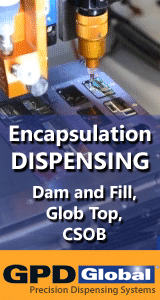Electronics Manufacturing Technical Articles
Papers and articles related to SMT, PCB & EMS industry.
- SMTnet
- »
- Technical Library
1882 SMT / PCB Assembly Related Technical Articles

Global manufacturer of XPM Reflow Ovens, ZEVA Selective Soldering and Delta Wave Soldering Equipment.
Camdenton, Missouri, USA

Headquartered in Germany and founded by Manfred Zollner in 1965, Zollner Elektronik AG has successfully grown to become one of the largest and most formidable Electronic Manufacturing & Engineering Services providers in the world today.
Sterling, Virginia, USA

Foresite is a process consulting house and analytial laboratory dedicated to solving product reliability challenges for electronics manufacturers.
Kokomo, Indiana, USA
Cranfield University is a British postgraduate public research university specialising in science, engineering, design, technology and management. Cranfield was founded as the College of Aeronautics in 1946.
Bedford,
Khmelnytsky National University
Established in 1962, Khmelnytskyi National University is a non-profit public higher-education institution located in the urban setting of the medium city of Khmelnitsky (population range of 250,000-499,999 inhabitants), Khmelnytsk
Khmelnytskyi Oblast, Ukraine

Siemens Process Industries and Drives
Siemens industrial manufacturing software, process automation, and automation and drives technology increases flexibility, cuts market launch lead time, and significantly reduces energy for manufacturing companies.
Alpharetta, Georgia, USA
Consultant / Service Provider, Manufacturer, Training Provider
ASM International, formerly known as the American Society for Metals, an association of materials-centric engineers and scientists. ASM is dedicated to informing, educating, & connecting the materials community to solve problems.
Materials Park, Ohio, USA
Shenzhen PTI Technology CO.,LTD
Our company was established in 2004, Main products: ICT on-line tester, ICT, functional testing machine 、FCT、 TSI、 automatic test and control system (ATE), test automation solutions, etc.
深圳, China

A multinational electronics manufacturing services (EMS) company.
Toronto, Ontario, Canada
Manufacturer, Standards Setting / Certification, Training Provider

iNEMI (International Electronics Manufacturing Initiative)
iNEMI is an industry-led consortium focused on identifying and closing technology gaps, which includes the development and integration of the electronics industry supply infrastructure.
Herndon, Virginia, USA
Pages: 1 2 3 4 5 6 7 8 9 10 11 12 13 14 15 16 17 18 19 20 21 22 23 24 25 26 27 28 29 30 31 32 33 34 35 36 37 38 39 40 41 42 43 44 45 46 47 48 49 50 51 52 53 54 55 56 57 58 59 60 61 62 63 64 65 66 67 68 69 70 71 72 73 74 75 76 77 78 79 80 81 82 83 84 85 86 87 88 89 90 91 92 93 94 95 96 97 98 99 100 101 102 103 104 105 106 107 108 109 110 111 112 113 114 115 116 117 118 119 120 121 122 123 124 125 126 127 128 129 130 131 132 133 134 135 136 137 138 139 140 141 142 143 144 145 146 147 148 149 150 151 152 153 154 155 156 157 158 159 160 161 162 163 164 165 166 167 168 169 170 171 172 173 174 175 176 177 178 179 180 181 182 183 184 185 186 187 188 189








